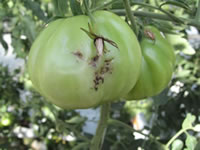
41st Meeting of the Panel on Phytosanitary Measures
Paris, 2009-02-16/20
The Panel met in Paris at the headquarters of the French NPPO. The main task of this Panel is to evaluate risks presented by specific pests and design phytosanitary measures to avoid their introduction and spread.
EPPO lists of pests recommended for regulation
On a case by case basis, the Panel reviewed PRAs prepared by the Expert Working Groups for PRA and performed pest risk management when necessary, and it also reviewed national PRAs. It recommended to the Working Party the addition of Xanthomonas axonopodis pv. allii (A1 List), and of Metamasius hemipterus (A2 List).
The following pests were evaluated but not recommended for regulation: Raoiella indica, Iris yellow spot virus, Diaphana indica,Meloidogyne minor.
The Panel reviewed the present situation of A1 pests and recommended the transfer from the A1 to the A2 List of Agrilus planipennis, Aleurocanthus spiniferus, and Tuta absoluta.

Damage of Tuta absoluta on tomato fruit.
Courtesy: Dr Andrea Minuto, CERSAA, Albenga (IT)
The Panel reviewed the Action List; it agreed that the following pests should be withdrawn as they have been on the Action List for more than 5 years (but they will remain on the A1/A2 Lists): Stegophora ulmea, Dryocosmus kuriphilus, Erschoviella musculana, Lepidosaphes ussuriensis, Maconellicoccus hirsutus, Malacosoma paralella, Chrysanthemum stem necrosis virus (CSNV), Cucumber vein yellowing virus.
Alert List
As usual, the Panel reviewed in detail the EPPO Alert List whose purpose is to warn countries about possible new risks, and in certain cases to propose candidates for PRA and eventually regulation. The Panel suggested emerging pests that should be added to the Alert List. Considering that the alert had been given and that no further action was needed, the Panel decided to delete Lissorhoptrus oryzophilus, and Phakopsora pachyrhizi.
Pest Risk Analysis
The Panel reviewed the PRAs produced by 2 Expert Working Groups for PRA and run the management part of the decision support scheme to finalize the selection of management options. The Panel stressed the interest to be able to use National PRAs as a basis to make recommendations for regulation. It further elaborated guidelines for the Panel to review national PRAs.
The Panel established the priorities for the organization of EWGs for PRA. The selection was made taking the into account following elements: geographical distribution, importance of the crop(s) concerned, risk of natural spread to enter the region or for further spread within the region, potential pathways, economic impact, environmental impact, possibilities of control, similarities with other known cases, availability and validity of data. The following pests were considered as having a high priority: Saperda candida, Acidovorax avenae pv. citrulli, Epitrix similaris, Phytophthora kernoviae, Phytophthora pinifolia, Tomato viroids.
Candidate pests for re-evaluation
The Panel elaborated a list of pests candidate for deregulation by considering the following criteria:
- does geographical distribution match the endangered area?
- is there economic impact?
- is there official control in place?
This list will be provided to the Working Party on Phytosanitary Regulations which will have to define priorities, and some pests will be considered in 2010 by the Panel.
Other topics
The Panel compared ISPM no. 31 Methodologies for sampling of consignments and EPPO Standard PM 3/65 Sampling of consignments for visual phytosanitary inspection and agreed to withdraw PM 3/65. Elements of PM 3/65 not covered in ISPM no. 31 should be included in a revision of the Standard PM 3/72 Elements common to inspection of places of production, area-wide surveillance, inspection of consignments and lot identification.
The Panel was updated on the EU project PRATIQUE and discussed systems approach in the context of Europe.
